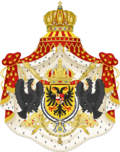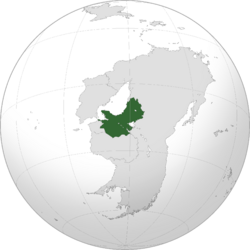Second Empire of Nadauro: Difference between revisions
No edit summary |
mNo edit summary |
||
| (4 intermediate revisions by the same user not shown) | |||
| Line 76: | Line 76: | ||
|coa_size = 120px | |coa_size = 120px | ||
|coat_alt = [[Coat of arms of Nadauro|Coat of arms]] | |coat_alt = [[Coat of arms of Nadauro|Coat of arms]] | ||
|other_symbol = [[File:Greater imperial arms of Nadauro small.png|120px]] | |||
|other_symbol_type = Greater imperial arms | |||
|symbol_type = <!-- Displayed text for link under symbol. Default "Coat of arms" --> | |symbol_type = <!-- Displayed text for link under symbol. Default "Coat of arms" --> | ||
|symbol_type_article = <!-- Link target under symbol image. Default: Coat of arms of {{{common_name}}} --> | |symbol_type_article = <!-- Link target under symbol image. Default: Coat of arms of {{{common_name}}} --> | ||
| Line 147: | Line 149: | ||
}} | }} | ||
The '''Second Empire of Nadauro''' ({{wp|Portuguese language|Lavish}}: ''Segundo Império de Anadaúro''), officially the '''Empire of Nadauro''' ({{wp|Portuguese language|Lavish}}: ''Império de Anadaúro'') and also referred to as '''imperial Nadauro''' or simply '''Nadauro''', was the {{wp|nation state}} and {{wp|constitutional monarchy}} that comprised the territories of modern-day [[Nadauro]] and other [[Elia | The '''Second Empire of Nadauro''' ({{wp|Portuguese language|Lavish}}: ''Segundo Império de Anadaúro''), officially the '''Empire of Nadauro''' ({{wp|Portuguese language|Lavish}}: ''Império de Anadaúro'') and also referred to as '''imperial Nadauro''' or simply '''Nadauro''', was the {{wp|nation state}} and {{wp|constitutional monarchy}} that comprised the territories of modern-day [[Nadauro]] and other [[Elia Australis|Elia Australian]] countries from the beginning of the [[National Schism (Nadauro)|National Schism]] on 4 February 1886 until the enactment of the reformed [[Constitution of Nadauro]] on 10 August 1950, resulting in the formation of a [[Third Empire of Nadauro|Third Empire]]. | ||
Nadauro's first attempt at [[United Provinces of Nadauro|a republican federation]] collapsed when political disputes between President [[Geraldo Duarte]], Vice President [[Luís Benito de Gerosa]] and general [[Emanuel Teixeira]] escalated into the [[National Schism (Nadauro)|National Schism]] in April of 1885. A military {{wp|coup d'état}} led by Teixeira restored power to the culturally influential [[Emperor of Nadauro|Pedro I]] as [[Emperor of Nadauro|Emperor]] and imposed a royalist {{wp|junta}}, called the [[Teixeirato]]; from 1890 to 1920, Nadauro underwent a period of large-scale {{wp|industrialization}}, {{wp|militarization}}, and {{wp|centralization}}. Unlike most of the Eastern Hemisphere's republics in the latter 19th century, the Empire witnessed vibrant economic and population growth as well as political stability. The successful [[Second Helmish–Nadauran War]] in 1909 and X in 19X cemented Nadauro's position as an emerging {{wp|great power}}. | Nadauro's first attempt at [[United Provinces of Nadauro|a republican federation]] collapsed when political disputes between President [[Geraldo Duarte]], Vice President [[Luís Benito de Gerosa]] and general [[Emanuel Teixeira]] escalated into the [[National Schism (Nadauro)|National Schism]] in April of 1885. A military {{wp|coup d'état}} led by Teixeira restored power to the culturally influential [[Emperor of Nadauro|Pedro I]] as [[Emperor of Nadauro|Emperor]] and imposed a royalist {{wp|junta}}, called the [[Teixeirato]]; from 1890 to 1920, Nadauro underwent a period of large-scale {{wp|industrialization}}, {{wp|militarization}}, and {{wp|centralization}}. Unlike most of the Eastern Hemisphere's republics in the latter 19th century, the Empire witnessed vibrant economic and population growth as well as political stability. The successful [[Second Helmish–Nadauran War]] in 1909 and X in 19X cemented Nadauro's position as an emerging {{wp|great power}}. | ||
| Line 153: | Line 155: | ||
The economic turmoil of the X in 1919 led to a rise of political {{wp|militarism}}, {{wp|nationalism}} and ultimately {{wp|national syndicalism}}; [[Lúcio Cabral]] of the [[Statist Party (Nadauro)|Statist Party]] [[Apreensão (Teleon)|assumed]] the position of prime minister under [[Emperor of Nadauro|Luís III]] on 20 June 1921 and initiated the era of {{wp|totalitarianism|totalitarian}} [[Statist Nadauro]]. This ideological shift prompted Nadauro to pursue economic {{wp|autarky}}, an aggressive foreign policy of {{wp|expansionism}} and {{wp|imperialism}} ([[Esfera legítima]]), and military alliances with [[Falland]] and [[Razan]]. During the [[Third Helmish–Nadauran War]] in 1934, Nadauro consolidated its territorial ambitions and conducted [[X genocide|a pacifying genocide]] against the X. | The economic turmoil of the X in 1919 led to a rise of political {{wp|militarism}}, {{wp|nationalism}} and ultimately {{wp|national syndicalism}}; [[Lúcio Cabral]] of the [[Statist Party (Nadauro)|Statist Party]] [[Apreensão (Teleon)|assumed]] the position of prime minister under [[Emperor of Nadauro|Luís III]] on 20 June 1921 and initiated the era of {{wp|totalitarianism|totalitarian}} [[Statist Nadauro]]. This ideological shift prompted Nadauro to pursue economic {{wp|autarky}}, an aggressive foreign policy of {{wp|expansionism}} and {{wp|imperialism}} ([[Esfera legítima]]), and military alliances with [[Falland]] and [[Razan]]. During the [[Third Helmish–Nadauran War]] in 1934, Nadauro consolidated its territorial ambitions and conducted [[X genocide|a pacifying genocide]] against the X. | ||
On 8 August 1936, Statist Nadauro officially entered the [[Great War (Teleon)|Great War]] as a [[Sydenham Powers|Sydenham Power]] and was initially vastly successful in its military campaigns; by 1937, Nadauro controlled almost the entirety of northern Elia | On 8 August 1936, Statist Nadauro officially entered the [[Great War (Teleon)|Great War]] as a [[Sydenham Powers|Sydenham Power]] and was initially vastly successful in its military campaigns; by 1937, Nadauro controlled almost the entirety of northern Elia Australis and encroached upon the [[Free States]] [[South Coast (Free States)|south coast]]. However, a series of [[Transmedan Powers|Transmedan]] victories at X and X, as well as [[Trindade Plan|the failed attempted invasion of the Free States]] forced Nadauro to adopt a strictly defensive strategy from 1938 onwards. [[Transmedan invasion of Nadauro|Transmedan landings in X and Yecahual]] led to the fall of the Statist regime and [[Surrender of Nadauro|an unconditional surrender]] by the rump government on 25 March 1940. Consequently, Nadauro was [[Occupied Nadauro|occupied]] by Transmedan forces and governed by the [[Transmedan Control Council for Nadauro|Control Council]]. Under its supervision, [[Constitution of Nadauro|a new constitution]] was enacted on 10 August 1950 and {{wp|abdication|abdicated}} [[Emperor of Nadauro|Agustín I]]'s son, [[Emperor of Nadauro|Luís IV]], became Emperor. The post-war [[Third Empire of Nadauro|Third Empire]] would remain a democratic constitutional monarchy until [[Caravelas regime|a return to authoritarian military rule]] under [[Hermes Caravelas]] in 1973. | ||
==Terminological overview== | ==Terminological overview== | ||
| Line 165: | Line 167: | ||
{{Template:Nadaurotopics}} | {{Template:Nadaurotopics}} | ||
[[Category:Nadauro]] | [[Category:Nadauro]] | ||
[[Category:History of Nadauro]] | |||
[[Category:Former countries (Teleon)]] | |||
Latest revision as of 10:36, 23 June 2024
This article is incomplete because it is pending further input from participants, or it is a work-in-progress by one author. Please comment on this article's talk page to share your input, comments and questions. Note: To contribute to this article, you may need to seek help from the author(s) of this page. |
Empire of Nadauro Império do Anadaúro (Lavish) | |||||||||||
|---|---|---|---|---|---|---|---|---|---|---|---|
| 1885–1950 | |||||||||||
Flag (1885–1940)
| |||||||||||
| Motto: Força ou Morte (Lavish) "Strength or Death" | |||||||||||
| Anthem: O Reinado do Imperador (Lavish) "The Emperor's Reign" | |||||||||||
Greater imperial arms | |||||||||||
 The Empire of Nadauro at its peak and largest territorial extent in 1938. | |||||||||||
| Status |
| ||||||||||
| Capital | Forte de Agosto (1885–1894) Itabira (1894–1850) | ||||||||||
| Common languages | Lavish | ||||||||||
| Religion | Gregorianism | ||||||||||
| Demonym(s) | Nadauran | ||||||||||
| Government | Unitary constitutional monarchy (1885–1921)
| ||||||||||
| Emperor | |||||||||||
• 1885–1902 | Pedro I | ||||||||||
• 1902–1922 | Luís III | ||||||||||
• 1922–1927 | Pedro II | ||||||||||
• 1927–1950 | Agustín I | ||||||||||
| Prime Minister | |||||||||||
• 1885–1899 (first) | Emanuel Teixeira | ||||||||||
• 1921–1940 | Lúcio Cabral | ||||||||||
• 1947–1950 (last) | Maurício Álvarez dos Reis | ||||||||||
| Legislature | National Congress | ||||||||||
| Senate | |||||||||||
| Chamber of Representatives | |||||||||||
| Historical era | 1885–1950 | ||||||||||
• Beginning of the National Schism | 17 April 1885 | ||||||||||
| 4 February 1886 | |||||||||||
| 25 March 1886 | |||||||||||
| 10 July 1909 | |||||||||||
| 20 June 1921 | |||||||||||
| 2 May 1930 | |||||||||||
| 11 January 1934 | |||||||||||
| 8 August 1936 | |||||||||||
| 25 March 1940 | |||||||||||
| 10 August 1950 | |||||||||||
| Population | |||||||||||
• 1900 | 26,800,000 | ||||||||||
• 1930 | 44,570,000 | ||||||||||
| Currency | Nadauran coroa | ||||||||||
| |||||||||||
| Today part of | |||||||||||
The Second Empire of Nadauro (Lavish: Segundo Império de Anadaúro), officially the Empire of Nadauro (Lavish: Império de Anadaúro) and also referred to as imperial Nadauro or simply Nadauro, was the nation state and constitutional monarchy that comprised the territories of modern-day Nadauro and other Elia Australian countries from the beginning of the National Schism on 4 February 1886 until the enactment of the reformed Constitution of Nadauro on 10 August 1950, resulting in the formation of a Third Empire.
Nadauro's first attempt at a republican federation collapsed when political disputes between President Geraldo Duarte, Vice President Luís Benito de Gerosa and general Emanuel Teixeira escalated into the National Schism in April of 1885. A military coup d'état led by Teixeira restored power to the culturally influential Pedro I as Emperor and imposed a royalist junta, called the Teixeirato; from 1890 to 1920, Nadauro underwent a period of large-scale industrialization, militarization, and centralization. Unlike most of the Eastern Hemisphere's republics in the latter 19th century, the Empire witnessed vibrant economic and population growth as well as political stability. The successful Second Helmish–Nadauran War in 1909 and X in 19X cemented Nadauro's position as an emerging great power.
The economic turmoil of the X in 1919 led to a rise of political militarism, nationalism and ultimately national syndicalism; Lúcio Cabral of the Statist Party assumed the position of prime minister under Luís III on 20 June 1921 and initiated the era of totalitarian Statist Nadauro. This ideological shift prompted Nadauro to pursue economic autarky, an aggressive foreign policy of expansionism and imperialism (Esfera legítima), and military alliances with Falland and Razan. During the Third Helmish–Nadauran War in 1934, Nadauro consolidated its territorial ambitions and conducted a pacifying genocide against the X.
On 8 August 1936, Statist Nadauro officially entered the Great War as a Sydenham Power and was initially vastly successful in its military campaigns; by 1937, Nadauro controlled almost the entirety of northern Elia Australis and encroached upon the Free States south coast. However, a series of Transmedan victories at X and X, as well as the failed attempted invasion of the Free States forced Nadauro to adopt a strictly defensive strategy from 1938 onwards. Transmedan landings in X and Yecahual led to the fall of the Statist regime and an unconditional surrender by the rump government on 25 March 1940. Consequently, Nadauro was occupied by Transmedan forces and governed by the Control Council. Under its supervision, a new constitution was enacted on 10 August 1950 and abdicated Agustín I's son, Luís IV, became Emperor. The post-war Third Empire would remain a democratic constitutional monarchy until a return to authoritarian military rule under Hermes Caravelas in 1973.


